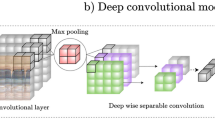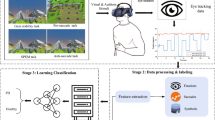Abstract
Oculomotor alterations are a promising biomarker to detect and characterize Parkinson’s disease (PD), even in prodromal stages. Nowadays, however, only global and simplified gaze trajectories are used to approximate the complex interactions between neuromotor commands and ocular muscles. Besides, the acquisition of such signals often requires sophisticated calibration and invasive settings. This work presents a novel imaging biomarker for PD assessment that models ocular fixational movements, recorded with conventional cameras. Firstly, a video acceleration magnification is performed to enhance small relevant fixation patterns on standard gaze video recordings. Hence, from each video are extracted a set of spatio-temporal slices, which thereafter are represented as convolutional feature maps, recovered as the first-layer responses of pre-trained CNN architectures. The feature maps are then efficiently encoded by means of covariance matrices to train a support vector machine and perform the disease classification. From a set of 130 recordings of 13 PD patients and 13 age-matched controls, the proposed approach achieved an average accuracy of 95.4% and an AUC of 0.984, following a leave-one-patient-out cross-validation scheme. The proposed imaging-based descriptor properly captures known disease tremor patterns, since PD classification performance is outstanding when augmented motion frequencies were fixed within tremor-related ranges. These results suggest a successful PD characterization from fixational eye motion patterns using ordinary videos.









Similar content being viewed by others
Notes
A preliminary version of this work appeared in [38]. In this extended version: (1) it was included a considerable extension of the experimental evaluation, (2) it was performed an exhaustive analysis and description of the proposed strategy, and (3) it was considered new CNN architectures for eye-fixation representation.
Preliminar work [38] presented on CIARP 2019 was evaluated with a total of 6 PD patients and 6 control subjects.
The ImageNet classification challenge, with a total training set of around 1.2 million samples.
References
Abdulhay E, Arunkumar N, Narasimhan K, Vellaiappan E, Venkatraman V (2018) Gait and tremor investigation using machine learning techniques for the diagnosis of Parkinson disease. Future Gener Comput Syst 83:366–373
Adhikari S, Stark DE (2017) Video-based eye tracking for neuropsychiatric assessment. Ann N Y Acad Sci 1387(1):145–152
Ajay J, Song C, Wang A, Langan J, Li Z, Xu W (2018) A pervasive and sensor-free deep learning system for parkinsonian gait analysis. In: 2018 IEEE EMBS international conference on biomedical & health informatics (BHI). IEEE, pp 108–111
Archibald NK, Hutton SB, Clarke MP, Mosimann UP, Burn DJ (2013) Visual exploration in Parkinson’s disease and Parkinson’s disease dementia. Brain 136(3):739–750
Belić M, Bobić V, Badža M, Šolaja N, Đurić-Jovičić M, Kostić VS (2019) Artificial intelligence for assisting diagnostics and assessment of Parkinson’s disease—a review. Clin Neurol Neurosurg 184:105442
Bhatia KP, Bain P, Bajaj N et al (2018) Consensus statement on the classification of tremors, from the task force on tremor of the international Parkinson and movement disorder society. Mov Disord 33(1):75–87
Caramia C, Torricelli D, Schmid M, Muñoz-Gonzalez A, Gonzalez-Vargas J, Grandas F, Pons JL (2018) IMU-based classification of Parkinson’s disease from gait: a sensitivity analysis on sensor location and feature selection. IEEE J Biomed Health Inform 22(6):1765–1774
Carson TB, Sutton SZ (2018) Application for smart phone or related devices for use in assessment of vestibulo-ocular reflex. US Patent App. 15/569,472
Chang CC, Lin CJ (2011) LIBSVM: a library for support vector machines. ACM Trans Intell Syst Technol 2:27:1–27:27
Chollet F (2017) Xception: deep learning with depthwise separable convolutions. In: Proceedings of the IEEE conference on computer vision and pattern recognition, pp 1251–1258
Donahue J, Jia Y, Vinyals O, Hoffman J, Zhang N, Tzeng E, Darrell T (2014) Decaf: a deep convolutional activation feature for generic visual recognition. In: International conference on machine learning, pp 647–655
Ekker MS, Janssen S, Seppi K et al (2017) Ocular and visual disorders in Parkinson’s disease: common but frequently overlooked. Parkinsonism Relat Disord 40:1–10
Ewenczyk C, Mesmoudi S, Gallea C, Welter ML, Gaymard B, Demain A, Cherif LY, Degos B, Benali H, Pouget P et al (2017) Antisaccades in Parkinson disease: a new marker of postural control? Neurology 88(9):853–861
Fleet DJ, Jepson AD (1990) Computation of component image velocity from local phase information. Int J Comput Vis 5(1):77–104
Fukushima K, Ito N, Barnes GR, Onishi S, Kobayashi N, Takei H, Olley PM, Chiba S, Inoue K, Warabi T (2015) Impaired smooth-pursuit in Parkinson’s disease: normal cue-information memory, but dysfunction of extra-retinal mechanisms for pursuit preparation and execution. Physiol Rep 3(3):e12361
Gatys L, Ecker AS, Bethge M (2015) Texture synthesis using convolutional neural networks. In: Advances in neural information processing systems, pp 262–270
Gitchel GT, Wetzel PA, Baron MS (2012) Pervasive ocular tremor in patients with Parkinson disease. Arch Neurol 69(8):1011–1017
Gitchel GT, Wetzel PA, Qutubuddin A, Baron MS (2014) Experimental support that ocular tremor in Parkinson’s disease does not originate from head movement. Parkinsonism Relat Disord 20(7):743–747
Goetz CG, Poewe W, Rascol O et al (2004) Movement disorder society task force report on the Hoehn and Yahr staging scale: status and recommendations the movement disorder society task force on rating scales for Parkinson’s disease. Mov Disord 19(9):1020–1028
Goldberg ME, Walker MF (2013) The control of gaze. In: Kandel ER, Schwartz JH, Jessell TM, Siegelbaum SA, Hudspeth AJ (eds) Principles of neural science, 5th edn. McGraw-Hill, New York, pp 894–916
Gorges M, Müller HP, Lulé D et al (2016) The association between alterations of eye movement control and cerebral intrinsic functional connectivity in Parkinson’s disease. Brain Imaging Behav 10(1):79–91
Hanuška J, Bonnet C, Rusz J et al (2015) Fast vergence eye movements are disrupted in Parkinson’s disease: a video-oculography study. Parkinsonism Relat Disord 21(7):797–799
He K, Zhang X, Ren S, Sun J (2016) Deep residual learning for image recognition. In: Proceedings of the IEEE conference on computer vision and pattern recognition, pp 770–778
Hu K, Wang Z, Martens KE, Lewis S (2018) Vision-based freezing of gait detection with anatomic patch based representation. In: Asian conference on computer vision. Springer, Berlin, pp 564–576
Huang G, Liu Z, Van Der Maaten L, Weinberger KQ (2017) Densely connected convolutional networks. In: Proceedings of the IEEE conference on computer vision and pattern recognition, pp 4700–4708
Iranzo A, Santamaria J, Tolosa E (2016) Idiopathic rapid eye movement sleep behaviour disorder: diagnosis, management, and the need for neuroprotective interventions. Lancet Neurol 15(4):405–419
Jankovic J (2008) Parkinson’s disease: clinical features and diagnosis. J Neurol Neurosurg Psychiatry 79(4):368–376
Kaski D, Saifee TA, Buckwell D, Bronstein AM (2013) Ocular tremor in Parkinson’s disease is due to head oscillation. Mov Disord 28(4):534–537
Khosla A, Kim D (2015) Optical imaging devices: new technologies and applications. CRC Press, Boca Raton
Kubis A, Szymański A, Przybyszewski AW (2015) Fuzzy rough sets theory applied to parameters of eye movements can help to predict effects of different treatments in Parkinson’s patients. In: International conference on pattern recognition and machine intelligence. Springer, Berlin, pp 325–334
Lai HY, Saavedra-Peña G, Sodini C, Heldt T, Sze V (2018) Enabling saccade latency measurements with consumer-grade cameras. In: 2018 25th IEEE international conference on image processing (ICIP). IEEE, pp 3169–3173
Lal V, Truong D (2019) Eye movement abnormalities in movement disorders. Clin Parkinsonism Relat Disord 1:54–63
Larrazabal A, Cena CG, Martínez C (2019) Video-oculography eye tracking towards clinical applications: a review. Comput Biol Med 108:57–66
Poewe W, Seppi K, Tanner CM, Halliday GM, Brundin P, Volkmann J, Schrag AE, Lang AE (2017) Parkinson disease. Nat Rev Dis Primers 3:17013
Portilla J, Simoncelli EP (2000) A parametric texture model based on joint statistics of complex wavelet coefficients. Int J Comput Vis 40(1):49–70
Rizzo G, Copetti M, Arcuti S et al (2016) Accuracy of clinical diagnosis of Parkinson disease a systematic review and meta-analysis. Neurology 86(6):566–576
Salat D, Noyce AJ, Schrag A, Tolosa E (2016) Challenges of modifying disease progression in prediagnostic Parkinson’s disease. Lancet Neurol 15(6):637–648
Salazar I, Pertuz S, Contreras W, Martínez F (2019) Parkinsonian ocular fixation patterns from magnified videos and CNN features. In: 24th Iberoamerican congress on pattern recognition, vol 11896. Springer, Berlin, pp 740–750
Sharif Razavian A, Azizpour H, Sullivan J, Carlsson S (2014) CNN features off-the-shelf: an astounding baseline for recognition. In: Proceedings of the IEEE conference on computer vision and pattern recognition workshops, pp 806–813
Simonyan K, Zisserman A (2014) Very deep convolutional networks for large-scale image recognition. arXiv:1409.1556
Sledzianowski A, Szymanski A, Drabik A, Szlufik S, Koziorowski DM, Przybyszewski AW (2019) Measurements of antisaccades parameters can improve the prediction of Parkinson’s disease progression. In: Asian conference on intelligent information and database systems. Springer, Berlin, pp 602–614
Szegedy C, Ioffe S, Vanhoucke V, Alemi AA (2017) Inception-v4, inception-resnet and the impact of residual connections on learning. In: Thirty-first AAAI conference on artificial intelligence
Szymański A, Szlufik S, Koziorowski DM, Habela P, Przybyszewski AW (2016) Building intelligent classifiers for doctor-independent Parkinson’s disease treatments. In: Conference of information technologies in biomedicine. Springer, Berlin, pp 267–276
Turcano P, Chen JJ, Bureau BL, Savica R (2018) Early ophthalmologic features of Parkinson’s disease: a review of preceding clinical and diagnostic markers. J Neurol 1–9
Venuto CS, Potter NB, Ray Dorsey E, Kieburtz K (2016) A review of disease progression models of Parkinson’s disease and applications in clinical trials. Mov Disord 31(7):947–956
Zhang Y, Pintea SL, Van Gemert JC (2017) Video acceleration magnification. In: Computer vision and pattern recognition
Zhang Y, Yan A, Liu B, Wan Y, Zhao Y, Liu Y, Tan J, Song L, Gu Y, Liu Z (2018) Oculomotor performances are associated with motor and non-motor symptoms in Parkinson’s disease. Front Neurol 9:960
Acknowledgements
The authors express their gratitude to the Parkinson foundation FAMPAS (Fundación del Adulto Mayor y Parkinson Santander) and the local elderly institution Asilo San Rafael for making possible the recording of the dataset proposed in this work. Also, many thanks to the Vicerrectoría de Investigación y Extensión of the Universidad Industrial de Santander for supporting this research work by the project “Reconocimiento continuo de expresiones cortas del lenguaje de señas registrado en secuencias de video”, with SIVIE code 2430.
Author information
Authors and Affiliations
Corresponding author
Additional information
Publisher's Note
Springer Nature remains neutral with regard to jurisdictional claims in published maps and institutional affiliations.
Rights and permissions
About this article
Cite this article
Salazar, I., Pertuz, S., Contreras, W. et al. A convolutional oculomotor representation to model parkinsonian fixational patterns from magnified videos. Pattern Anal Applic 24, 445–457 (2021). https://doi.org/10.1007/s10044-020-00922-4
Received:
Accepted:
Published:
Issue Date:
DOI: https://doi.org/10.1007/s10044-020-00922-4




